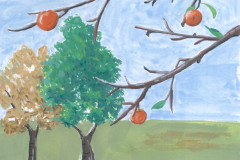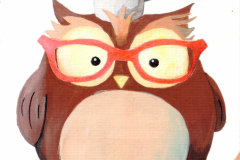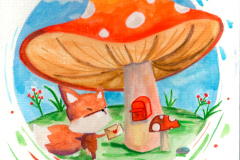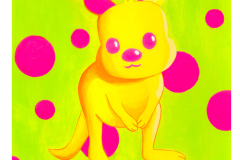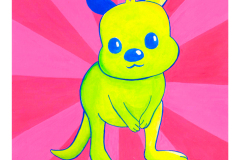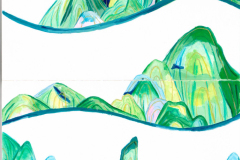Introduction
Canvas art offers a rewarding way to express your creativity. It involves painting on a durable fabric stretched across a wooden frame. This medium works well with many types of paint, including gouache, which is known for its opacity and quick drying time. Gouache allows both beginners and experienced artists to produce vibrant and striking artworks with relative ease. Whether you want to create a bright poster or a delicate illustration, canvas combined with gouache gives you a versatile and accessible canvas to begin your art projects.
This article guides you through simple techniques for easy canvas art using gouache paint. You will learn how to prepare your canvas, work with gouache, and try different project ideas suited for various skill levels. With practical steps and clear instructions, your canvas art journey will become enjoyable and effortless. You will also discover how to overcome challenges and maximize the unique properties of gouache to make your art stand out. Ready to start your canvas adventure? Let’s explore how gouache and canvas can bring your artistic vision to life.
Understanding Canvas as an Art Surface
Canvas is a sturdy fabric commonly used as a surface for painting. It became popular during the Renaissance when artists needed a durable, portable alternative to wood panels. The rough texture of canvas holds paint well, making colors appear vibrant. It provides a reliable foundation for various painting techniques, including gouache, because it can absorb moisture without warping easily.
Common canvas types include cotton, linen, and duck cloth, each differing in texture and strength. Preparing canvas often involves stretching it tightly over a wooden frame to create a smooth, taut surface. This helps prevent wrinkles and warping during painting.
Applying a primer or gesso makes the canvas less absorbent, allowing paints to glide on smoothly and preventing them from soaking into the fabric. Using canvas helps your artwork last longer and stay bright. Have you considered how the surface beneath your paint can shape your creative results?
Types of Canvas and Their Uses
Cotton canvas offers a soft, affordable option. It suits beginners and is widely available in art stores. Its texture is coarse, which can add interesting effects to your gouache paintings. Linen canvas has a tighter weave and strong fibers, providing a smooth surface preferred by professional artists. It holds paint evenly but costs more.
Duck canvas is a heavy, plain-woven fabric. It is durable and works well for large pieces or mixed media. For gouache, a smoother canvas, like linen or primed cotton, helps maintain the paint’s bright, matte finish. Choosing the right canvas depends on your project’s size, budget, and your desired texture.
What kind of finish do you want for your artwork? The canvas you pick influences your painting techniques and final look.
Preparing Your Canvas for Painting
Stretching a canvas over a wooden frame starts with securing the fabric at one side, then pulling it tight and fastening the opposite side. This keeps the surface firm and ready to work on. Beginners should practice gentle but firm stretching to avoid sagging or tearing the fabric.
After stretching, applying a primer can create an ideal surface for gouache. Use a brush or roller to spread gesso evenly and let it dry before painting. Primed canvas repels moisture, preventing gouache from soaking in too much and dulling the colors.
Handle your canvas with clean hands to avoid stains. Store it flat or upright in a dry place. Preparing your canvas properly saves time and gives your artwork a professional edge. How comfortable do you feel with setting up your own painting surface?
Introduction to Gouache Paint
Gouache is a water-based paint known for its thick, opaque quality. It contains pigment, water, and a binding agent, usually gum arabic. Unlike watercolor, gouache offers solid, matte coverage that hides layers beneath it, making it easier to correct or adjust your work as you paint.
Compared to acrylic paint, gouache remains soluble in water even after drying, which means you can reactivate it with water. Acrylic and gouache differ in finish too—acrylic dries to a glossy, waterproof surface, while gouache dries flat and matte. If you want a paint that lets you work quickly but also gives room for changes, gouache can fit your style well.
Have you thought about trying gouache for your next canvas project? Its qualities invite experimentation and are easy to control, especially on canvas surfaces, expanding what you can create with simple techniques.
Properties of Gouache
Gouache stands out because of its full opacity. It covers previous layers completely, which lets you paint light colors over dark ones easily. This property helps you add details later without worrying about muddy colors.
The paint dries fast, so you won’t need long breaks between layers. This speeds up the process, making it perfect for quick projects or when your creative ideas come fast. However, working quickly is key because once dry, gouache can leave visible brush strokes.
The reflective surface of gouache is minimal, providing a soft, matte finish that reduces glare. This matte look makes your colors stay true under different lights. Understanding these features helps you choose brushes, control water amounts, and plan your layers better on canvas.
History and Common Uses
Gouache has been used for centuries in calligraphy and manuscript illumination. By the 18th century, artists preferred it for posters and commercial illustrations because it dried fast and stood out with vivid details.
Today, designers and artists use gouache for graphic art, storyboarding, and personal paintings. Its ability to layer and correct easily makes it popular for beginners and professionals alike.
Have you noticed how gouache is often the choice for vibrant illustrations and expressive art? Its adaptability fits many creative goals, whether you want to produce bold canvas pieces or playful, easy projects at home.
Basic Gouache Techniques for Canvas
Gouache offers a smooth, versatile surface that welcomes simple techniques perfect for beginners. Start with a soft, flat brush for laying down broad areas of color. This brush type helps control the paint flow and provides more even coverage.
Hold your brush at a slight angle, applying gentle pressure to keep your strokes consistent. Avoid pressing too hard; this prevents scratching the canvas and uneven paint layers. Thin layers dry quickly, so build up your painting in stages.
Let each layer dry before applying the next. Gouache dries to an opaque finish, so layering adds richness without muddiness. Try short, light strokes when layering colors to maintain texture and vibrancy. Experiment with simple shapes or patterns first to master control.
Ask yourself: how can controlling brush pressure change the look of your strokes? By practicing smooth brushwork and patient layering, you’ll gain confidence and craft detailed scenes with ease.
Applying Gouache Evenly
To get smooth, opaque coverage with gouache, start with a well-mixed, slightly thick paint. Stir your paint before using to avoid lumps and inconsistent color.
Use a moderate amount of paint on your brush. Too much leads to drips and pooling; too little causes transparency. Apply the paint in even, uniform strokes moving in one direction.
Work quickly and avoid over-brushing areas that are starting to dry, which causes visible brush marks. If patches appear uneven, add a thin, fresh layer after the first dries.
A smooth canvas surface also helps. Lightly sanding or prepping the canvas ensures your brush glides evenly. Have you noticed how different brushes impact coverage? Choosing the right brush can transform your painting’s finish.
Layering and Blending Colors
Layering gouache paints lets you create depth and interesting color shifts on canvas. Wait for each layer to dry fully before adding the next to prevent lifting paint underneath.
Start with a base color. Once dry, apply a slightly diluted layer of another shade to blend edges gently. Use a clean, damp brush to soften the transition between colors while the paint is still wet.
For highlights or darker tones, apply opaque layers over dried colors. You can also mix colors on your palette or directly on the canvas for variation.
Try layering colors like blue over green for natural shadows or red over yellow to warm a scene. What combinations will you experiment with to add life to your canvas?
Choosing Easy Canvas Art Projects
Finding canvas art projects that match your skill level makes painting more enjoyable. You can create meaningful pieces without complex techniques or tools. Try projects designed around simple shapes, bold colors, and clear steps to build confidence and creativity.
Consider projects that allow you to explore gouache’s unique texture and opacity. Simple designs can teach you how to layer, blend, and balance color. These projects give clear results quickly, keeping you motivated.
What shapes or themes inspire you? Start with patterns or nature elements you like, then adjust colors and compositions as you go. This gives you freedom while you practice essential gouache skills. Easy projects can grow into more detailed artwork as you learn.
Simple Geometric Patterns
Creating abstract geometric patterns is a great way to use masking tape with gouache on canvas. Begin by taping off straight lines or shapes on a primed canvas to form triangles, squares, or stripes. The tape guides clean edges and shapes.
Next, choose a few gouache colors. Paint inside the tape sections with flat, even strokes. Wait for each section to dry before removing the tape carefully. This keeps your shapes crisp and sharp. You can layer colors or add new tape sections to create overlapping patterns.
Repeat these steps to fill your canvas with a balanced design. Try limiting the palette to two or three colors for a bold, modern look. How could changing your shapes or colors affect the overall mood? Experiment to find your style.
Nature-Inspired Art
Painting simple flowers, leaves, or other natural elements works well with gouache on canvas. Start by outlining basic shapes like circles for petals or elongated ovals for leaves. These forms keep the painting manageable.
Fill each shape with blocks of solid color or gently blend shades for a soft effect. Use contrasting colors to make each element stand out. Layering helps create depth, but keep brushstrokes loose and simple.
Try grouping shapes in small compositions for balanced artwork. Could you create a series of canvases with different plants or seasons? Nature offers many forms and colors that are easy to replicate yet striking. Your personal choices will make the project unique.
Tools and Materials Needed
You need the right tools to make gouache painting on canvas easier. Start with a sturdy canvas; choose one that has a good texture so the paint sticks well. Gouache is water-based but thicker than watercolor, so the canvas surface matters.
Next, pick gouache paints that offer good pigment quality. You do not want colors that fade or become dull when dry. A set with a range of colors gives you more options without buying many tubes.
Think about brushes carefully. Different brushes serve different purposes when working with gouache. Choosing the right size and shape helps control your strokes and the paint’s effect.
You will also need a palette to mix colors. A flat, non-absorbent palette works best because it keeps the paint moist longer. Prepare water containers to rinse brushes and cleaning cloths or paper towels to wipe them.
Keeping your workspace clean during painting saves time later. Will you use disposable cups or small jars for water? Have you thought about how to keep your brushes in good shape between uses? These small choices affect your painting experience a lot.
Choosing the Right Brushes
Brushes for gouache on canvas are different from those for watercolor or acrylic. Synthetic brushes are a good choice because they hold their shape and manage the thick paint well. Look for firm flat or round tips.
Flat brushes help cover large areas quickly. Use them for backgrounds or broad strokes. Round brushes allow for finer details and controlled lines. You can switch between sizes like 6, 10, and 12 for versatility.
Try a filbert brush if you want softer edges or blending effects. Its rounded tip is useful to move paint smoothly without harsh lines. Avoid brushes with very soft bristles because gouache can be heavy and might bend them.
Do you notice how each brush affects your strokes differently? Experiment with a few types to find what feels best for your style and project. That makes painting less frustrating and more enjoyable.
Other Helpful Supplies
A palette must hold your colors without soaking them up or drying too fast. Plastic or ceramic palettes work well. Try to have at least two palettes: one for mixing colors and another for pure paint.
Water containers help clean brushes and thin your paint. Use one for rinsing and another with clean water. Change water often to keep colors pure and prevent muddy mixes.
Keeping brushes clean during and after painting is important. Rinse them gently and reshape the bristles with your fingers. Avoid scrubbing hard; it damages brushes. Use brush soap or mild detergent occasionally to remove dried paint.
Protect your workspace with a plastic sheet or newspaper. You want to avoid stains on tables or floors. Have paper towels or cloth rags ready for quick wipes. These small steps keep your space tidy and make painting sessions smoother.
Mistakes to Avoid When Painting Gouache on Canvas
One common mistake is not accounting for how gouache changes as it dries. The paint often appears darker or more matte once dry. If you rely on the color while it’s wet, your final piece might look different than planned. Test colors on a separate canvas or paper to see how they transform before applying them to your artwork.
Another error is over-wetting the canvas. Gouache works best with a moderate amount of water. Applying too much can weaken the canvas fibers, causing warping or damage over time. Use a spray bottle to lightly mist if you need extra moisture rather than soaking the surface with a brush.
Too many thick layers risk cracking or flaking. Wait for each layer to dry completely before adding the next. This patience prevents the paint from lifting or becoming patchy. If a layer gets damaged, gently sanding it and repainting can fix the surface without ruining your entire piece.
Have you noticed your paint peeling or your canvas buckling? These problems often come from ignoring the drying behavior or over-saturating your canvas. Adjust your water use and drying time for better results and longer-lasting art.
Dealing with Drying Changes
Gouache dries quickly on canvas but can shift in color during this process. It often loses some shine and looks lighter or darker compared to its wet state. This change happens because water evaporates, causing pigments to settle differently.
Expect this shift by mixing a little extra pigment or layering colors to compensate. Try painting small patches first and allow them to dry completely. Observe how the color alters—this practice helps you predict the final look on your main canvas.
Use matte varnish or fixative only after the paint is fully dry. These finishes can also shift the appearance, so test them carefully. Is your color too dull after drying? Adding highlights or glazes will brighten the area without changing the entire hue.
Preventing Canvas Damage
The most frequent cause of canvas damage is saturating the surface with too much water or paint. Excess moisture stretches the canvas fibers, weakening their hold over time. This stretching leads to wrinkles or tears, especially with repeated over-wetting.
Control the amount of water on your brush by blotting it on a paper towel before applying paint. Thin the gouache just enough to flow smoothly but not drip. You want to keep the canvas surface firm throughout your work.
Using a primed canvas designed for gouache or acrylic will protect fibers better than raw canvas. Keep your paint layers thin and evenly spread. If you notice any warping, place your canvas under a flat, heavy surface once dry to help it flatten back.
Advanced Tips for Enhancing Your Canvas Art
Adding texture to your gouache paintings brings new depth and character. Try using a dry-brush technique by dipping your brush in paint, then removing most of it before applying it lightly on the canvas. This creates rough, scratchy strokes that catch light differently. Layering paints after the first layer dries allows you to build subtle or bold textures without muddying colors.
Think about which details could benefit from fine texture. Could a rough tree bark or soft fabric gain realism through dry-brush strokes? Experiment with varying pressure for different effects.
Incorporating mixed media can transform your canvas art. Use colored pencils or fine-tip markers to add sharp outlines or tiny details over dried gouache. Collage elements like paper cutouts or fabric scraps introduce unexpected shapes and textures.
Have you tried combining smooth gouache backgrounds with pencil sketches or paper shapes? These simple layers can make your artwork more dynamic and unique. Focus on blending rather than overwhelming the painting, so all materials enhance each other without competing for attention.
Displaying and Caring for Your Gouache Canvas Art
Your finished gouache canvas deserves attention when it comes to display and long-term care. Choosing the right spot to showcase your art can help maintain its colors and texture. Avoid places with direct sunlight, as UV rays may cause fading. Consistent temperature and humidity levels protect the paint and canvas from cracking or warping over time.
Using a protective coating like a matte varnish made specifically for gouache can seal your painting if you want extra durability, but always test it on a sample first. Also, keep your artwork away from damp rooms or kitchens where moisture tends to build up. How will you balance showing off your work while keeping it safe? Thoughtful placement makes all the difference in preserving your canvas masterpiece.
Framing and Hanging Tips
Select frames that offer both support and protection for your gouache canvas. Floating frames, for instance, leave space around the edges, showcasing the full artwork without touching the paint directly. Use acid-free mats if you want added style and preservation. These prevent your painting from sticking to the glass or frame backing.
When hanging, use sturdy hooks or wall anchors to prevent falls. Consider your wall material—drywall or brick—before choosing hanging hardware. Avoid spots where temperature shifts or vibrations occur, such as near doors or heating vents. Hanging at eye level creates better viewing and protects your art from accidental knocks. What framing style fits your room and art best?
Cleaning and Storage
Remove dust gently using a soft, dry brush or microfiber cloth. Avoid water or cleaning chemicals, since gouache can dissolve or smudge easily. Clean your canvas regularly to prevent buildup, especially if it’s in an open space.
If you need to store your painting, wrap it in acid-free paper. Avoid plastic wraps that trap moisture. Place the canvas flat or upright in a dry, cool area with moderate air circulation. When stacking multiple canvases, keep cardboard sheets between them to prevent scratches or dents. How will you organize your growing art collection without risking damage?
Conclusions
Your journey into gouache painting on canvas can be both enjoyable and rewarding. Understanding the basics of canvas preparation and gouache properties sets a strong foundation. Simple techniques and beginner projects offer a clear path to develop confidence and skill with this medium. Each project you complete improves your control over paint and brush. Experimenting with colors and shapes enhances your creative expression and artistic voice.
Taking care of your tools and artworks ensures they last and stay vibrant. Avoiding common mistakes helps maintain quality and satisfaction with each painting. You can continue to grow by exploring textured effects and mixed media. Displaying and storing your work properly lets you enjoy your creations for years. How will you begin your next canvas art project? With these tips, you hold the key to easy and effortless gouache art that fits your style and skill level.



















